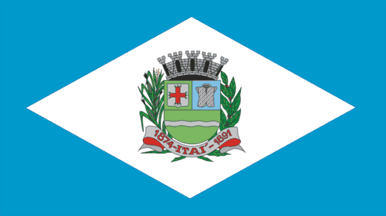 image by Ivan Sarajcic, 8 December
2005
image by Ivan Sarajcic, 8 December
2005
Last modified: 2012-12-15 by ian macdonald
Keywords: sao paulo | itaí |
Links: FOTW homepage |
search |
disclaimer and copyright |
write us |
mirrors
 image by Ivan Sarajcic, 8 December
2005
image by Ivan Sarajcic, 8 December
2005
A blue flag with a large white lozenge bearing the coat of arms.
Official website at
http://www.itai.sp.gov.br/
Dirk Sch÷nberger,
14 November 2012
Itaí was founded, as Santo Antônio da Ponta da Serra, in 1869 on the left bank of the Ticks' River, as Santo Antônio da Boa Vista, by Salvador da Silveira Freitas, José da Silveira Melo, Manoel Pedroso de Oliveira and Captain José Floriano de Freitas. The first settler of the place was Miguel Correa de Melo. The first mass was celebrated in the chapel in 1870. The parish of Santo Antônio da Boa Vista, part of the municipality of Faxina (today, Itapeva) was established on 16 April 1874 by Provincial Law no. 42. The municipality of Santo Antônio da Boa Vista was established on 1 May 1891 by State Decree No. 163 and inaugurated on 29 May 1891. The name of the municipality was changed to Itaí ( in Tupi-Guarani, "a river stone") on 13 December 1928 by Law No. 2,308; the same Law transferred the district of Caputera from Itaí to Faxina. State Decree- Law No. 6,530 of 3 July 1934 downgraded the municipality of Bom Sucesso to a district incorporated to Itaí. Bom Sucesso was eventually reestablished as the municipality of Paranapanema on 30 November 1944 by State Decree-Law No. 14,344;
Itaí is the birth place of Anésia Pinheiro Machado (1904-1999), the second woman in Brazil to obtain an air pilot license (FAI license No. 76, granted on 8 April 1922). The same year, she flew from São Paulo to Rio de Janeiro to celebrate the centenary of the independence of Brazil; in Rio, she was welcomed in Rio by the famous airman Alberto Santos Dumont (1873-1932), who offered her a gold medal she would keep as a talisman. In 1954, she was proclaimed the World Dean of Women's Aviation during the FAI conference held in Istanbul. Itaí is the birth place of Napoleão Mendes de Almeida (1911-1988), author of the "Gramática Metódica da Língua Portuguesa" (Methodic Grammar of Portuguese Language), of which more than 500,000 copies were sold.
The flag of Itaí is blue with a white lozenge charged with the municipal coat of arms. The flag is displayed in the Flag Gallery of auditorium "Ulisses Guimaraes", Sector S, No. 246.
Photos of the flag
http://www.itai.sp.gov.br/2012/wp-content/uploads/2012/03/Praça-da-bandeira_800x496.jpg
http://commons.wikimedia.org/wiki/File:Itaifotos.png
The coat of arms of Itaí is prescribed by Municipal Law No. 218 of 29 November 1958. "Per fess, 1a. Vert an escutcheon argent charged with a cross patty gules, 1b. Azure a pioneer's jacket argent, 2. Vert a fess wavy argent. The shield surmounted with a mural crown argent ports sable. The shield surrounded dexter by a plant of maize and dexter by a branch of coffee the two proper. Below the shield a scroll argent inscribed with the toponym 'ITAÍ' surrounded by the years '1874' and '1891' gules."
Green symbolize the fertile fields. Blue symbolizes knowledge and loyalty. The crown represents the origins and the traditions. The cross is St. Anthony's Cross, representing the patron saint of the municipality. The jack represent the pioneers. The fess wavy represents the Ticks' River. Maize and coffee are crops of the municipality. Year '1874' recalls the establishment of the parish, while year '1891' represents the establishment of the "vila".
http://www.itai.sp.gov.br/2012/a-cidade/brasao-e-bandeira -
Municipal website
http://commons.wikimedia.org/wiki/File:Bandeira_de_Ita%C3%AD_SP.jpg
Ivan Sache, 17 November 2012